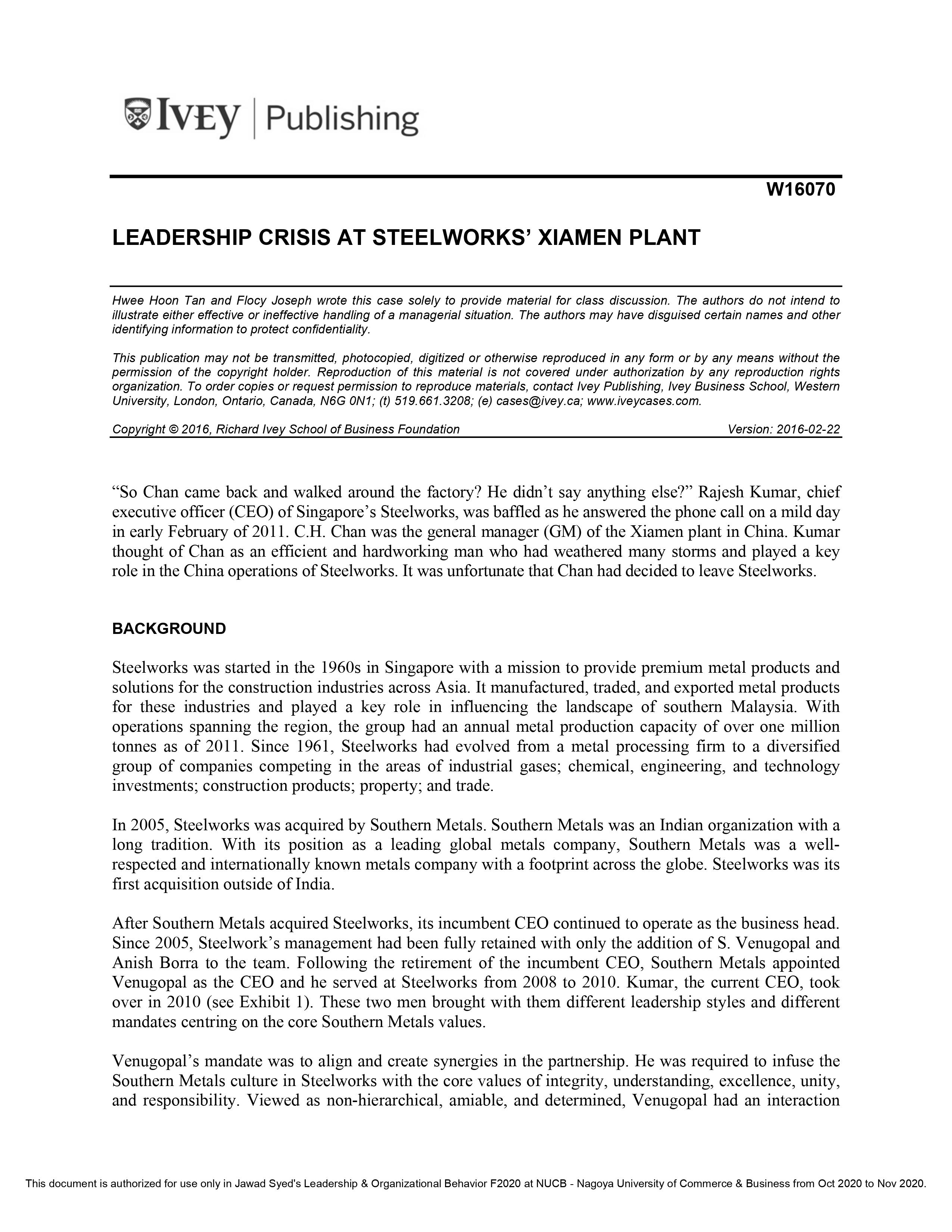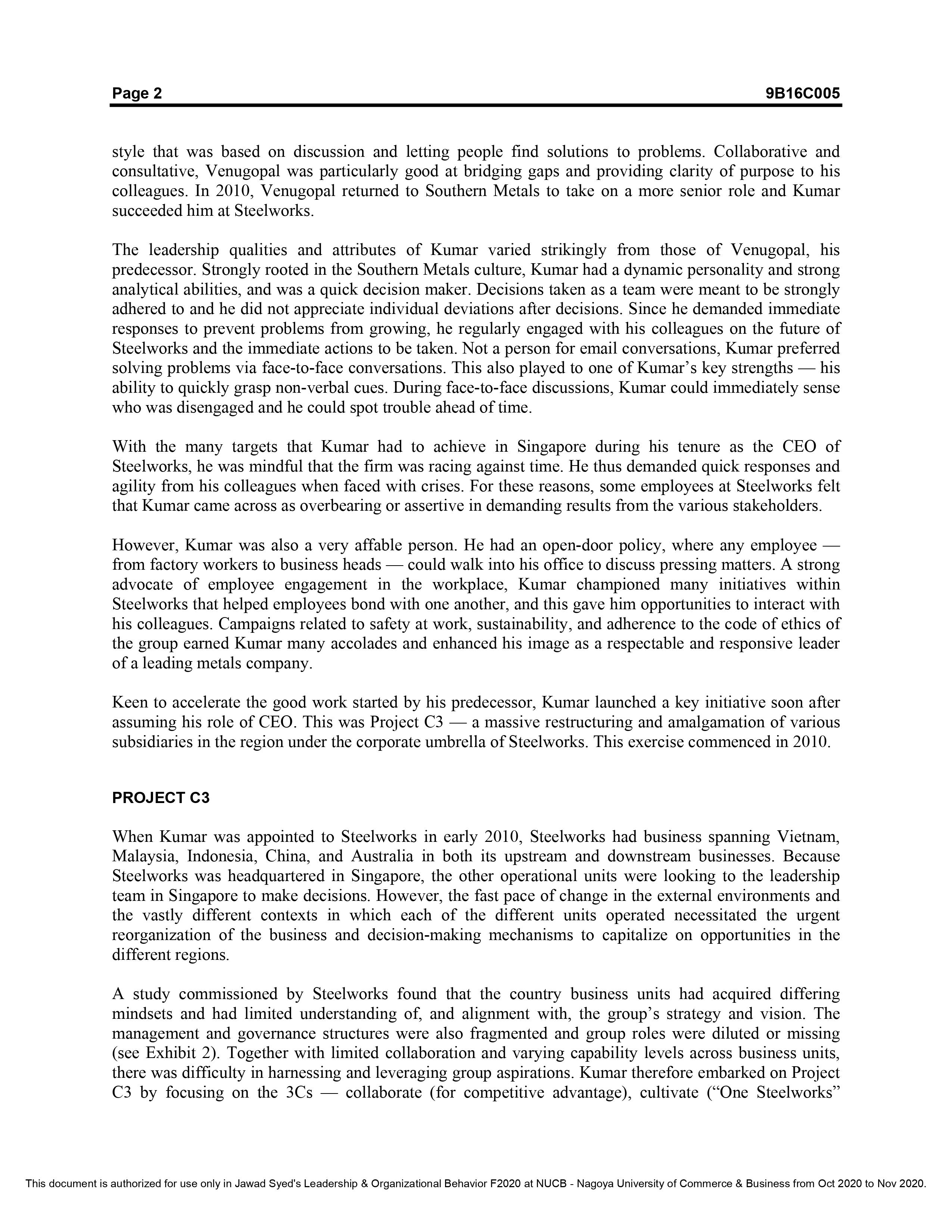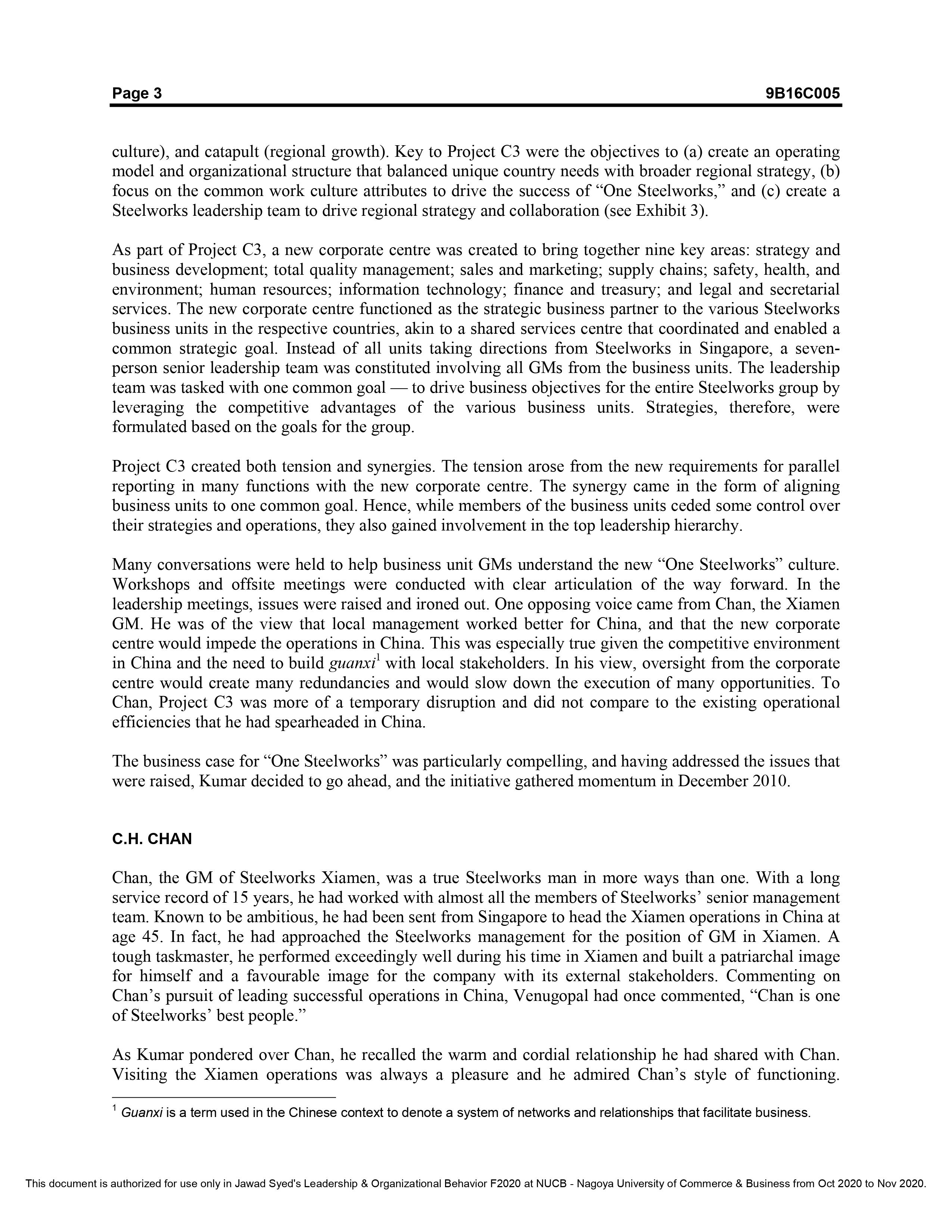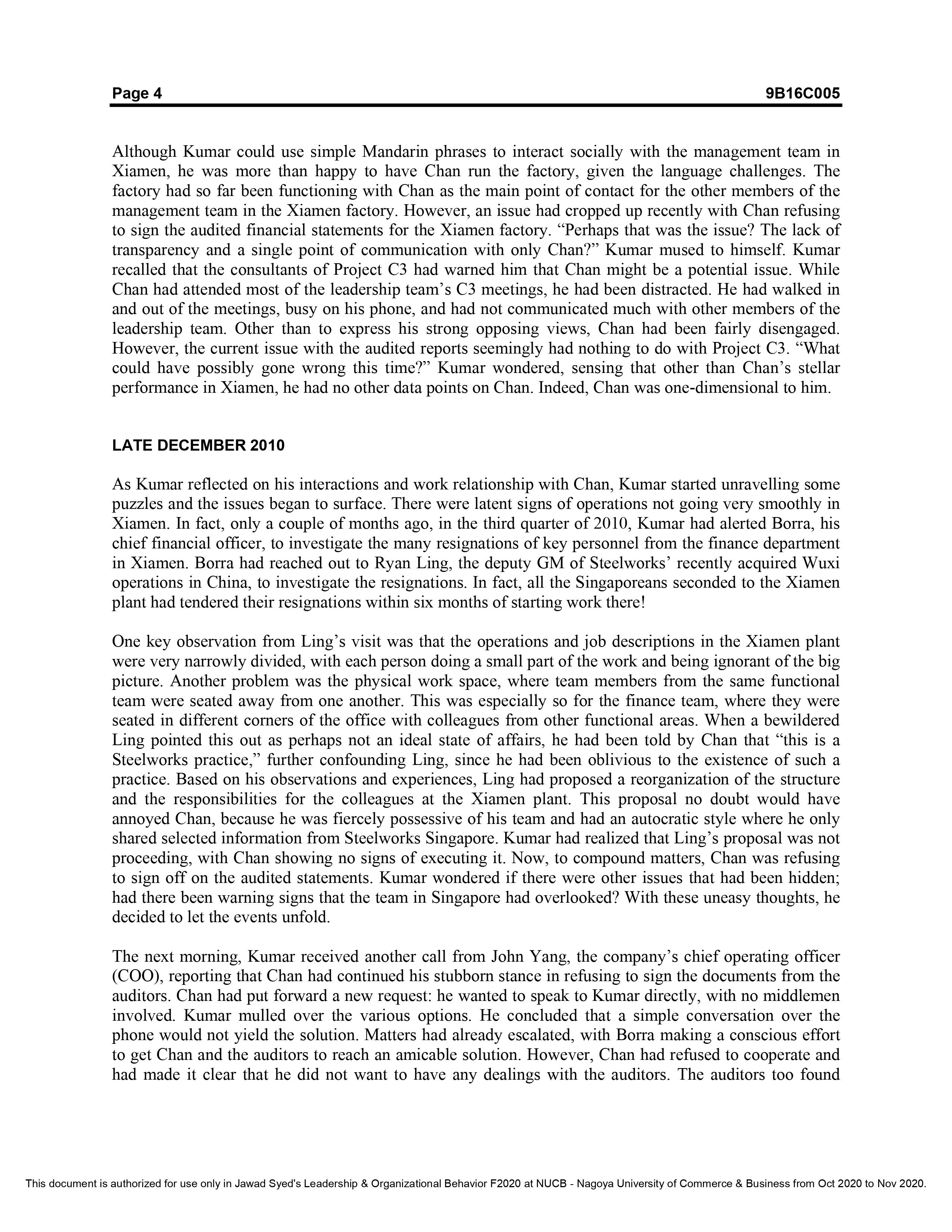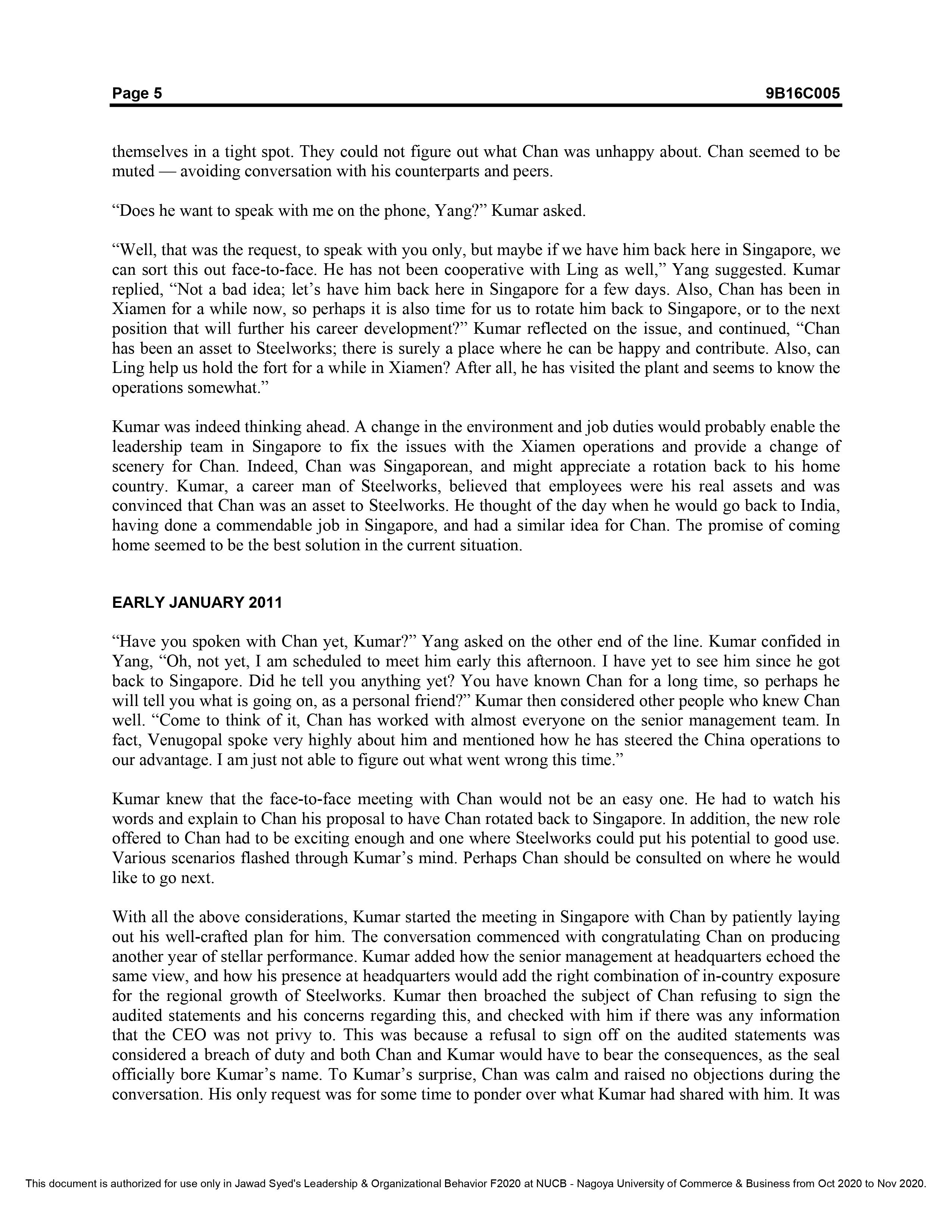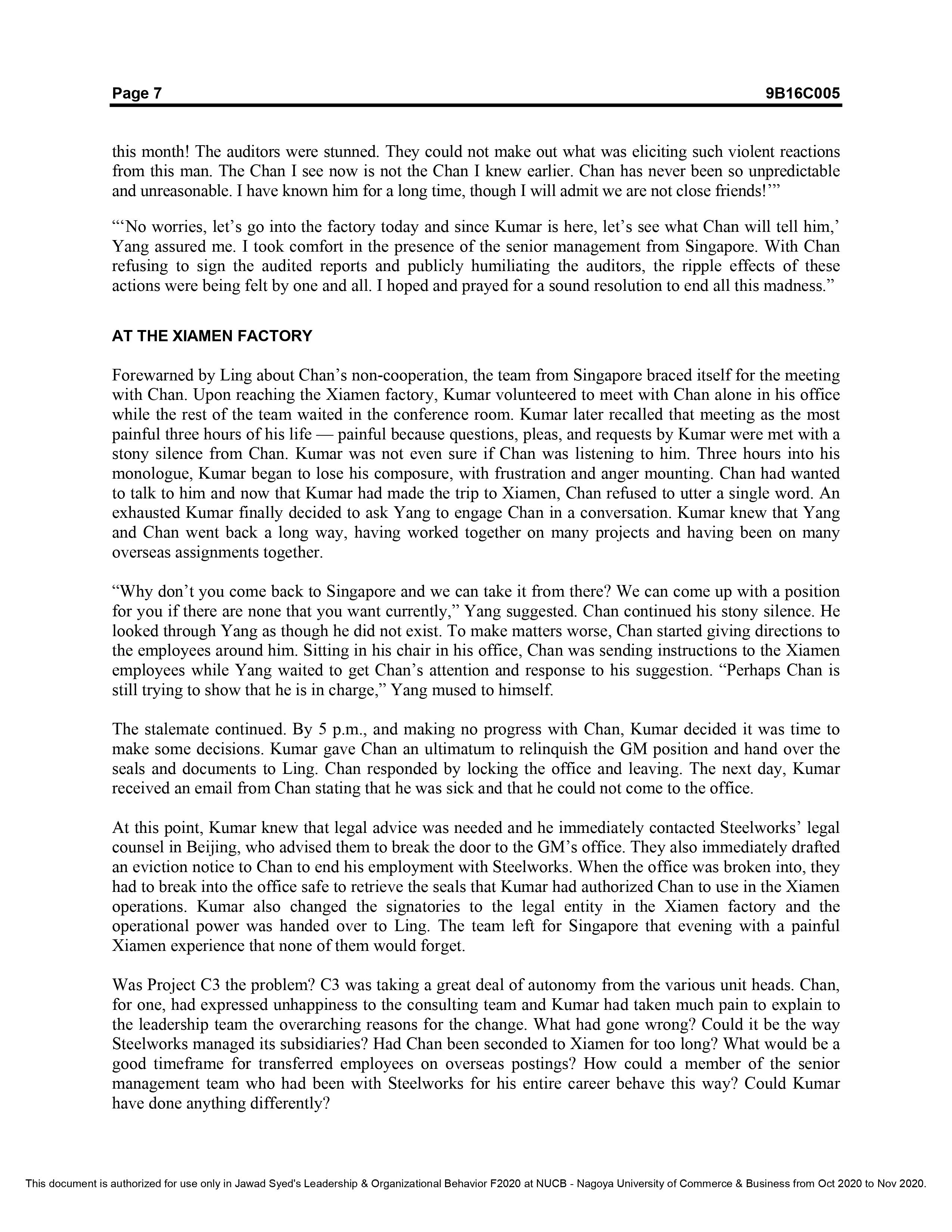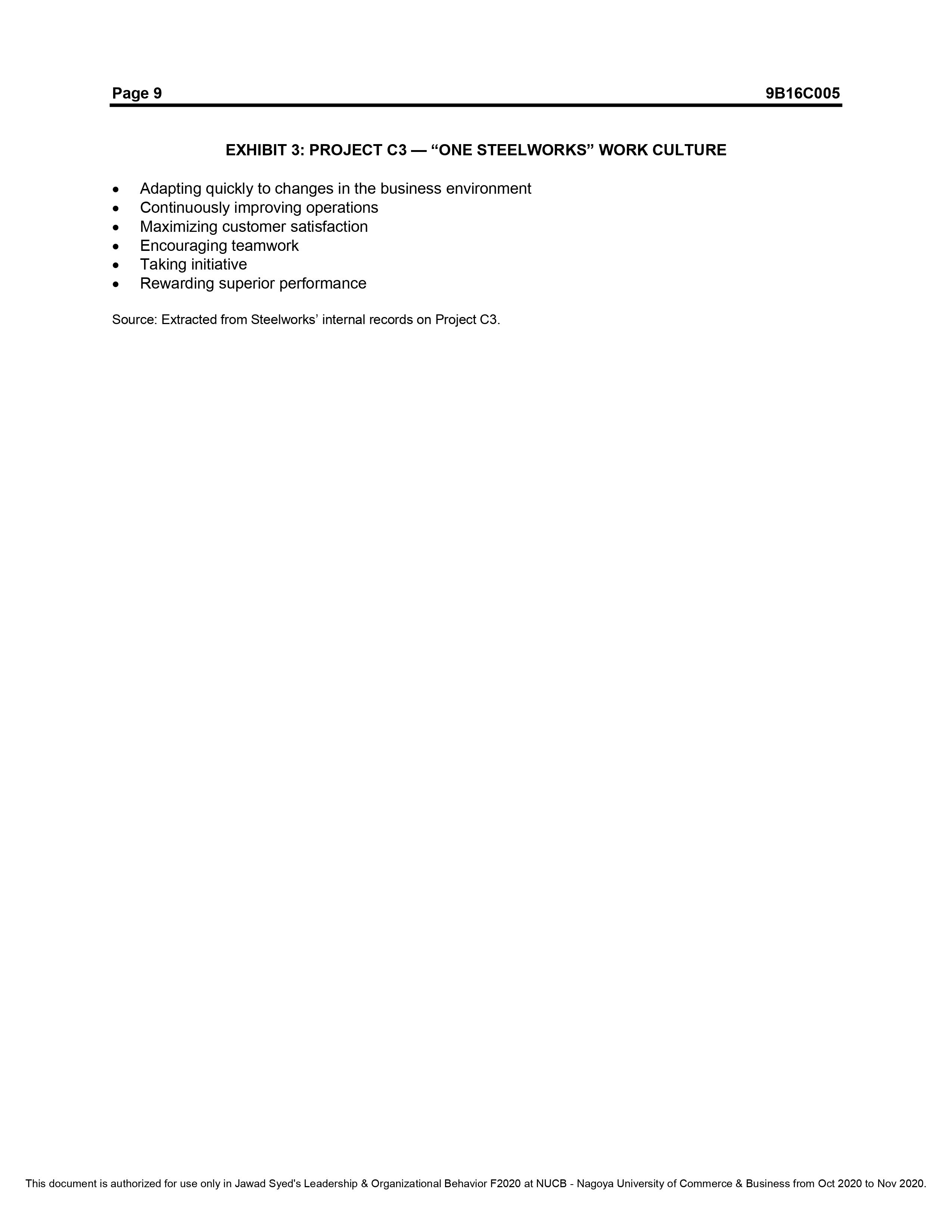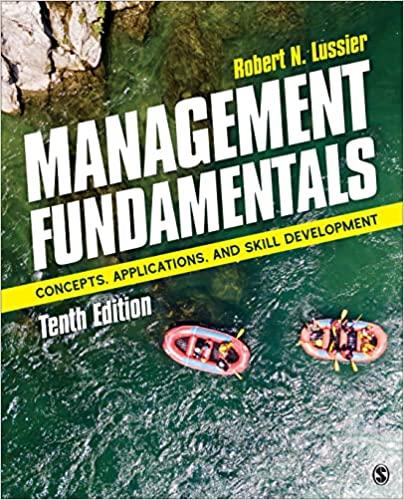Topic: Leadership, culture, diversity and values: Case : Leadership Crisis at Steelworks' Xiamen Plant - Ivey Case (Reading: Syed & Kramar - Chapter 1 -
Topic: Leadership, culture, diversity and values:
Case : Leadership Crisis at Steelworks' Xiamen Plant - Ivey Case
(Reading: Syed & Kramar - Chapter 1 - Context-Specific Human Resource Management; Robbins & Judge - Chapter 12 - Leadership; Kotter 2011- What leaders really do, HBR)
Assignment Questions:
- Is Kumar's leadership style autocratic or participative? Discuss.
- Is Chan's style competing or completing (refer to 360 leadership's lead across principle)?
- Taking the perspective of C.H. Chan, what do you think happened?
- How would you describe the relationship between Kumar and Chan? To what extent was there trust between them?
- To what extent did the cultural differences between (a) Kumar and Chan, and (b) Southern Metals and Steelworks play a role in this episode?
- What could Kumar have done differently in his relationship with Chan and in the Project C3 change initiative?
IVEY Publishing W16070 LEADERSHIP CRISIS AT STEELWORKS' XIAMEN PLANT Hwee Hoon Tan and Flocy Joseph wrote this case solely to provide material for class discussion. The authors do not intend to llustrate either effective or ineffective handling of a managerial situation. The authors may have disguised certain names and other identifying information to protect confidentiality. This publication may not be transmitted, photocopied, digitized or otherwise reproduced in any form or by any means without the permission of the copyright holder. Reproduction of this material is not covered under authorization by any reproduction rights organization. To order copies or request s or request permission to reproduce materials, contact Ivey Publishing, Ivey Business School, Western University, London, Ontario, Canada, N6G ON1; (t) 519.661.3208; (e) cases@ivey.ca; www.iveycases.com. Copyright @ 2016, Richard Ivey School of Business Foundation Version: 2016-02-22 "So Chan came back and walked around the factory? He didn't say anything else?" Rajesh Kumar, chief executive officer (CEO) of Singapore's Steelworks, was baffled as he answered the phone call on a mild day in early February of 2011. C.H. Chan was the general manager (GM) of the Xiamen plant in China. Kumar thought of Chan as an efficient and hardworking man who had weathered many storms and played a key role in the China operations of Steelworks. It was unfortunate that Chan had decided to leave Steelworks. BACKGROUND Steelworks was started in the 1960s in Singapore with a mission to provide premium metal products and solutions for the construction industries across Asia. It manufactured, traded, and exported metal products for these industries and played a key role in influencing the landscape of southern Malaysia. With operations spanning the region, the group had an annual metal production capacity of over one million tonnes as of 2011. Since 1961, Steelworks had evolved from a metal processing firm to a diversified group of companies competing in the areas of industrial gases; chemical, engineering, and technology investments; construction products; property; and trade. In 2005, Steelworks was acquired by Southern Metals. Southern Metals was an Indian organization with a long tradition. With its position as a leading global metals company, Southern Metals was a well- respected and internationally known metals company with a footprint across the globe. Steelworks was its first acquisition outside of India. After Southern Metals acquired Steelworks, its incumbent CEO continued to operate as the business head. Since 2005, Steelwork's management had been fully retained with only the addition of S. Venugopal and Anish Borra to the team. Following the retirement of the incumbent CEO, Southern Metals appointed Venugopal as the CEO and he served at Steelworks from 2008 to 2010. Kumar, the current CEO, took over in 2010 (see Exhibit 1). These two men brought with them different leadership styles and different mandates centring on the core Southern Metals values. Venugopal's mandate was to align and create synergies in the partnership. He was required to infuse the Southern Metals culture in Steelworks with the core values of integrity, understanding, excellence, unity, and responsibility. Viewed as non-hierarchical, amiable, and determined, Venugopal had an interaction This document is authorized for use only in Jawad Syed's Leadership & Organizational Behavior F2020 at NUCB - Nagoya University of Commerce & Business from Oct 2020 to Nov 2020.Page 2 931 60005 style that was based on discussion and letting people nd solutions to problems. Collaborative and consultative, Venugopal was particularly good at bridging gaps and providing clarity of purpose to his colleagues. In 2010, Venugopal returned to Southern Metals to take on a more senior role and Kumar succeeded him at Steelworks. The leadership qualities and attributes of Kumar varied strikingly from those of Venugopal, his predecessor. Strongly rooted in the Southern Metals culture, Kumar had a dynamic personality and strong analytical abilities, and was a quick decision maker. Decisions taken as a team were meant to be strongly adhered to and he did not appreciate individual deviations after decisions. Since he demanded immediate responses to prevent problems from growing, he regularly engaged with his colleagues on the future of Steelworks and the immediate actions to be taken. Not a person for email conversations, Kumar preferred solving problems via face-to-faee conversations. This also played to one of Kumar's key strengths his ability to quickly grasp non-verbal cues. During face-to-face discussions, Kumar could immediately sense who was disengaged and he could spot trouble ahead of time. With the many targets that Kumar had to achieve in Singapore during his tenure as the CEO of Steelworks, he was mindful that the rm was racing against time. He thus demanded quick responses and agility from his colleagues when faced with crises. For these reasons, some employees at Steelworks felt that Kumar came across as overbearing or assertive in demanding results from the various stakeholders. However, Kumar was also a very affable person. He had an open-door policy, where any employee from factory workers to business heads 7 could walk into his ofce to discuss pressing matters. A strong advocate of employee engagement in the workplace, Kumar championed many initiatives within Steelworks that helped employees bond with one another, and this gave him opportunities to interact with his colleagues. Campaigns related to safety at work, sustainability, and adherence to the code of ethics of the group earned Kumar many accolades and enhanced his image as a respectable and responsive leader of a leading metals company. Keen to accelerate the good work started by his predecessor, Kumar launched a key initiative soon after assuming his role of CEO. This was Project C3 a massive restructuring and amalgamation of various subsidiaries in the region under the corporate umbrella of Steelworks. This exercise commenced in 2010. PROJECT C3 When Kumar was appointed to Steelworks in early 2010, Steelworks had business spanning Vietnam, Malaysia, Indonesia, China, and Australia in both its upstream and downstream businesses. Because Steelworks was headquartered in Singapore, the other operational units were looking to the leadership team in Singapore to make decisions. However, the fast pace of change in the external environments and the vastly different contexts in which each of the different units operated necessitated the urgent reorganization of the business and decision-making mechanisms to capitalize on opportunities in the different regions. A study commissioned by Steelworks found that the country business units had acquired differing mindsets and had limited understanding of, and alignment with, the group's strategy and vision. The management and governance structures were also fragmented and group roles were diluted or missing (see Exhibit 2). Together with limited collaboration and varying capability levels across business units, there was difficulty in harnessing and leveraging group aspirations. Kumar therefore embarked on Project C3 by focusing on the 3Cs collaborate (for competitive advantage), cultivate (\"One Steelworks\" This document is authorized for use only in Jawad Syed's Leadership & Organizational Behavior F2020 at NUCB - Nagoya University of Commerce & Business from Oct 2020 to Nov 2020. Page 3 931 60005 culture), and catapult (regional growth). Key to Project C3 were the objectives to (a) create an operating model and organizational structure that balanced unique country needs with broader regional strategy, (b) focus on the common work culture attributes to drive the success of \"One Steelworks,\" and (c) create a Steelworks leadership team to drive regional strategy and collaboration (see Exhibit 3). As part of Project C3, a new corporate centre was created to bring together nine key areas: strategy and business development; total quality management; sales and marketing; supply chains; safety, health, and environment; human resources; information technology; finance and treasury; and legal and secretarial services. The new corporate centre functioned as the strategic business partner to the various Steelworks business units in the respective countries, akin to a shared services centre that coordinated and enabled a common strategic goal. Instead of all units taking directions from Steelworks in Singapore, a seven- person senior leadership team was constituted involving all GMs from the business units. The leadership learn was tasked with one common goal 7 to drive business objectives for the entire Steelworks group by leveraging the competitive advantages of the various business units. Strategies, therefore, were formulated based on the goals for the group. Project C3 created both tension and synergies. The tension arose from the new requirements for parallel reporting in many inctions with the new corporate centre. The synergy came in the form of aligning business units to one common goal. Hence, while members of the business units ceded some control over their strategies and operations, they also gained involvement in the top leadership hierarchy. Many conversations were held to help business unit GMs understand the new \"One Steelworks\" culture. Workshops and offsite meetings were conducted with clear articulation of the way forward. In the leadership meetings, issues were raised and ironed out. One opposing voice came from Chan, the Xiamen GM. He was of the view that local management worked better for China, and that the new corporate centre would impede the operations in China. This was especially true given the competitive environment in China and the need to build guanxi1 with local stakeholders. In his view, oversight from the corporate centre would create many redundancies and would slow down the execution of many opportunities. To Chan, Project C3 was more of a temporary disruption and did not compare to the existing operational efciencies that he had spearheaded in China. The business case for \"One Steelworks\" was particularly compelling, and having addressed the issues that were raised, Kumar decided to go ahead, and the initiative gathered momentum in December 2010. CH. CHAN Chan, the GM of Steelworks Xiamen, was a true Steelworks man in more ways than one. With a long service record of 15 years, he had worked with almost all the members of Steelworks' senior management team. Known to be ambitious, he had been sent from Singapore to head the Xiamen operations in China at age 45. In fact, he had approached the Steelworks management for the position of GM in Xiamen. A tough taskmaster, he performed exceedingly well during his time in Xiamen and built a patriarchal image for himself and a favourable image for the company with its external stakeholders. Commenting on Chan's pursuit of leading successful operations in China, Venugopal had once commented, \"Chan is one of Steelworks' best people.\" As Kumar pondered over Chan, he recalled the warm and cordial relationship he had shared with Chan. Visiting the Xiamen operations was always a pleasure and he admired Chan's style of functioning. 1 Guanxi is a term used in the Chinese context to denote a system of networks and relationships that facilitate business. This document is authorized for use only in Jawad Syed's Leadership & Organizational Behavior F2020 at NUCB - Nagoya University of Commerce & Business from Oct 2020 to Nov 2020. Page 4 931 60005 Although Kumar could use simple Mandarin phrases to interact socially with the management team in Xiamen, he was more than happy to have Chan run the factory, given the language challenges. The factory had so far been functioning with Chan as the main point of contact for the other members of the management team in the Xiamen factory. However, an issue had cropped up recently with Chan refusing to sign the audited nancial statements for the Xiamen factory. \"Perhaps that was the issue? The lack of transparency and a single point of communication with only Chan?\" Kumar mused to himself. Kumar recalled that the consultants of Project C3 had warned him that Chan might be a potential issue. While Chan had attended most of the leadership team's C3 meetings, he had been distracted. He had walked in and out of the meetings, busy on his phone, and had not communicated much with other members of the leadership team. Other than to express his strong opposing views, Chan had been fairly disengaged. However, the current issue with the audited reports seemingly had nothing to do with Project C3. \"What could have possibly gone wrong this time?\" Kumar wondered, sensing that other than Chan's stellar performance in Xiamen, he had no other data points on Chan. Indeed, Chan was one-dimensional to him. LATE DECEMBER 2010 As Kumar reected on his interactions and work relationship with Chan, Kumar started unravelling some puzzles and the issues began to surface. There were latent signs of operations not going very smoothly in Xiamen. In fact, only a couple of months ago, in the third quarter of 2010, Kumar had alerted Borra, his chief nancial ofcer, to investigate the many resignations of key personnel from the nance department in Xiamen. Borra had reached out to Ryan Ling, the deputy GM of Steelworks\" recently acquired Wuxi operations in China, to investigate the resignations. In fact, all the Singaporeans seconded to the Xiamen plant had tendered their resignations within six months of starting work there! One key observation from Ling's visit was that the operations and job descriptions in the Xiamen plant were very narrowly divided, with each person doing a small part of the work and being ignorant of the big picture. Another problem was the physical work space, where team members from the same functional team were seated away from one another. This was especially so for the nance team, where they were seated in different corners of the office with colleagues from other functional areas. When a bewildered Ling pointed this out as perhaps not an ideal state of affairs, he had been told by Chan that \"this is a Steelworks practice,\" further confounding Ling, since he had been oblivious to the existence of such a practice. Based on his observations and experiences, Ling had proposed a reorganization of the structure and the responsibilities for the colleagues at the Xiamen plant. This proposal no doubt would have annoyed Chan, because he was ercely possessive of his team and had an autocratic style where he only shared selected information from Steelworks Singapore. Kumar had realized that Ling's proposal was not proceeding, with Chan showing no signs of executing it. Now, to compound matters, Chan was refusing to sign off on the audited statements. Kumar wondered if there were other issues that had been hidden; had there been warning signs that the team in Singapore had overlooked? With these uneasy thoughts, he decided to let the events unfold. The next morning, Kumar received another call from John Yang, the company's chief operating officer (COO), reporting that Chan had continued his stubborn stance in refusing to sign the documents from the auditors. Chan had put forward a new request: he wanted to speak to Kumar directly, with no middlemen involved. Kumar mulled over the various options. He concluded that a simple conversation over the phone would not yield the solution. Matters had already escalated, with Borra making a conscious effort to get Chan and the auditors to reach an amicable solution. However, Chan had refused to cooperate and had made it clear that he did not want to have any dealings with the auditors. The auditors too found This document is authorized for use only in Jawad Syed's Leadership & Organizational Behavior F2020 at NUCB - Nagoya University of Commerce & Business from Oct 2020 to Nov 2020. Page 5 931 60005 themselves in a tight spot. They could not gure out what Chan was unhappy about. Chan seemed to be muted avoiding conversation with his counterparts and peers. \"Does he want to speak with me on the phone, Yang?\" Kumar asked. \"Well, that was the request, to speak with you only, but maybe if we have him back here in Singapore, we can sort this out face-to-face. He has not been cooperative with Ling as well,\" Yang suggested. Kumar replied, \"Not a bad idea; let's have him back here in Singapore for a few days. Also, Chan has been in Xiamen for a while now, so perhaps it is also time for us to rotate him back to Singapore, or to the next position that will further his career development?\" Kumar reected on the issue, and continued, \"Chan has been an asset to Steelworks; there is surely a place where he can be happy and contribute. Also, can Ling help us hold the fort for a while in Xiamen? After all, he has visited the plant and seems to know the operations somewhat.\" Kumar was indeed thinking ahead. A change in the environment and job duties would probably enable the leadership team in Singapore to x the issues with the Xiamen operations and provide a change of scenery for Chan. lndccd, Chan was Singaporean, and might appreciate a rotation back to his home country. Kumar, a career man of Steelworks, believed that employees were his real assets and was convinced that Chan was an asset to Steelworks. He thought of the day when he would go back to India, having done a commendable job in Singapore, and had a similar idea for Chan. The promise of coming home seemed to be the best solution in the current situation. EARLY JANUARY 2011 \"Have you spoken with Chan yet, Kumar?\" Yang asked on the other end of the line. Kumar conded in Yang, \"Oh, not yet, I am scheduled to meet him early this afternoon. I have yet to see him since he got back to Singapore. Did he tell you anything yet? You have known Chan for a long time, so perhaps he will tell you what is going on, as a personal friend?\" Kumar then considered other people who knew Chan well. \"Come to think of it, Chan has worked with almost everyone on the senior management team. In fact, Venugopal spoke very highly about him and mentioned how he has steered the China operations to our advantage. I am just not able to figure out what went wrong this time.\" Kumar knew that the face-to-face meeting with Chan would not be an easy one. He had to watch his words and explain to Chan his proposal to have Chan rotated back to Singapore. In addition, the new role offered to Chan had to be exciting enough and one where Steelworks could put his potential to good use. Various scenarios ashed through Kumar's mind. Perhaps Chan should be consulted on where he would like to go next. With all the above considerations, Kumar started the meeting in Singapore with Chan by patiently laying out his well-crafted plan for him. The conversation commenced with congratulating Chan on producing another year of stellar performance. Kumar added how the senior management at headquarters echoed the same view, and how his presence at headquarters would add the right combination of incountry exposure for the regional growth of Steelworks. Kumar then broached the subject of Chan refusing to sign the audited statements and his concerns regarding this, and checked with him if there was any information that the CEO was not privy to. This was because a refusal to sign off on the audited statements was considered a breach of duty and both Chan and Kumar would have to bear the consequences, as the seal ofcially bore Kumar's name. To Kumar's surprise, Chan was calm and raised no objections during the conversation. His only request was for some time to ponder over what Kumar had shared with him. It was This document is authorized for use only in Jawad Syed's Leadership & Organizational Behavior F2020 at NUCB - Nagoya University of Commerce & Business from Oct 2020 to Nov 2020. Page 6 931 60005 Kumar who then proposed that Chan take the next two days to reect and deliberate on the new assignment at the headquarters. The meeting concluded with both agreeing to meet two days later to nalize their course of action. THE NEXT DAY \"What? Chan has gone back to Xiamen? He said he would take two days to consider my proposal and the issues I raised; he didn't talk about ying back so soon!\" said a stunned Kumar. \"Chan emailed me just now that he didn't want the rotation and the new position you have offered and has own back to Xiamen,\" said Yang, equally stunned. For the rst time in their careers, Kumar and Yang were dealing with a situation where a senior member of the management team was behaving in a rather illogical and deant manner. Kumar knew he had to take matters into his own hands and deal with this before the issue escalated. \"Looks like we have to make a trip to Xiamen immediately. Could you ask Fanny Ang and John Yang to come along with us? Also, please get Ling to get there ASAP. I would like Ling to assume the position of GM. Wc cannot wait anymore; we have to get this issuc ironed out before the Chincsc New Year annual holidays in February.\" What Kumar did not share was that just the previous evening, he had again received a call from the auditors stating that not signing the auditor's report could lead to other complications. LATE JANUARY 2011 Ling's Recollection Ryan Ling, the deputy GM of Steelworks' Wuxi operations in China, had his own experiences with Chan, which he rccountcd as follows. \"I left for Xiamen immediately after receiving the call from Singapore. It was a difcult encounter with Chan. I told him that I had bccn instructed to take ovcr the GM position. Chan was angry. He refused to accept me and insisted that he was the GM until he received the ofcial notication from Kumar. What was even more worrisome was that he wanted to call a press conference to talk about what the auditors did wrong. It was becoming difcult for me to put sense into Chan. I attempted to convince him to be realistic, as he had to rst work things out with us, tell us what was going on with the audit and the root cause of his unhappiness. I knew I was going there for just the interim period and Chan was certainly not happy to see me. With all the records still showing Chan as the GM, he was responsible for the entire Xiamen operations. Strangely, the auditors did not have any issues with his fmancials. I just could not understand why he was doing this big song and dance. Chan had decided that he did not want to talk to anyone. He even told me, 'You are not qualied to talk to me. ' It was absurd!\" \"Shortly after my encounter with Chan, the team from Singapore arrived. Kumar was accompanied by John Yang (COO), Fanny Ang (vice-president of human resources), and Rick Teo (legal counsel).\" \"'So what is the status now?' Yang asked, as soon as he saw me.\" \"'No status,' I replied. 'Chan said that I am not qualied to talk to him and he has been waiting for all of you to turn up. In the meantime, you may want to know that I talked to the auditors and something unbelievable has happened. When the auditors visited the plant, Chan took them to the employee conference room and told the employees that these auditors were the reason why they were not getting their salaries for This document is authorized for use only in Jawad Syed's Leadership & Organizational Behavior F2020 at NUCB - Nagoya University of Commerce & Business from Oct 2020 to Nov 2020. Page 7 931 60005 this month! The auditors were stunned. They could not make out what was eliciting such violent reactions from this man. The Chan I see now is not the Chan I knew earlier. Chan has never been so unpredictable and unreasonable. I have known him for a long time, though I will admit we are not close friends! \"' t\" No worries, let's go into the factory today and since Kumar is here, let's see what Chan will tell him,\" Yang assured me. I took comfort in the presence of the senior management from Singapore. With Chan refusing to sign the audited reports and publicly humiliating the auditors, the ripple effects of these actions were being felt by one and all. I hoped and prayed for a sound resolution to end all this madness.\" AT THE XIAMEN FACTORY Forewarned by Ling about Chan's non-cooperation, the team from Singapore braced itself for the meeting with Chan. Upon reaching the Xiamen factory, Kumar volunteered to meet with Chan alone in his ofce while the rest of the team waited in the conference room. Kumar later recalled that meeting as the most painful three hours of his life 7 painful because questions, pleas, and requests by Kumar were met with a stony silence from Chan. Kumar was not even sure if Chan was listening to him. Three hours into his monologue, Kumar began to lose his composure, with frustration and anger mounting. Chan had wanted to talk to him and now that Kumar had made the trip to Xiamen, Chan refused to utter a single word. An exhausted Kumar nally decided to ask Yang to engage Chan in a conversation. Kumar knew that Yang and Chan went back a long way, having worked together on many projects and having been on many overseas assignments together. \"Why don't you come back to Singapore and we can take it from there? We can come up with a position for you if there are none that you want currently,\" Yang suggested. Chan continued his stony silence. He looked through Yang as though he did not exist. To make matters worse, Chan started giving directions to the employees around him. Sitting in his chair in his ofce, Chan was sending instructions to the Xiamen employees while Yang waited to get Chan's attention and response to his suggestion. \"Perhaps Chan is still trying to show that he is in charge,\" Yang mused to himself. The stalemate continued. By 5 p.m., and making no progress with Chan, Kumar decided it was time to make some decisions. Kumar gave Chan an ultimatum to relinquish the GM position and hand over the seals and documents to Ling. Chan responded by locking the ofce and leaving. The next day, Kumar received an email from Chan stating that he was sick and that he could not come to the ofce. At this point, Kumar knew that legal advice was needed and he immediately contacted Steelworks' legal counsel in Beijing, who advised them to break the door to the GM's ofce. They also immediately drafted an eviction notice to Chan to end his employment with Steelworks. When the ofce was broken into, they had to break into the ofce safe to retrieve the seals that Kumar had authorized Chan to use in the Xiamen operations. Kumar also changed the signatories to the legal entity in the Xiamen factory and the operational power was handed over to Ling. The team left for Singapore that evening with a painful Xiamen experience that none of them would forget. Was Project C3 the problem? C3 was taking a great deal of autonomy from the various unit heads. Chan, for one, had expressed unhappiness to the consulting team and Kumar had taken much pain to explain to the leadership team the overarching reasons for the change. What had gone wrong? Could it be the way Steelworks managed its subsidiaries? Had Chan been seconded to Xiamen for too long? What would be a good timeframe for transferer employees on overseas postings? How could a member of the senior management team who had been with Steelworks for his entire career behave this way? Could Kumar have done anything differently? This document is authorized for use only in Jawad Syed's Leadership & Organizational Behavior F2020 at NUCB - Nagoya University of Commerce & Business from Oct 2020 to Nov 2020. Page 8 9B16C005 EXHIBIT 1: ORGANIZATIONAL CHART OF STEELWORKS' HEAD OFFICE CEO Rajesh Kumar Legal Counsel HR Director COO CFO Rick Teo Fanny Ang John Yang Anish Borra Staff Staff Staff Staff CFO: chief financial officer Source: Extracted from Steelworks' organizational chart. EXHIBIT 2: ORGANIZATIONAL CHART OF STEELWORKS' BUSINESS UNITS BEFORE PROJECT C3 Steelworks Inc. (Singapore HQ) Steelworks Steelworks Inc. Steelworks Inc. Steelworks PT Steelworks Inc. (Xiamen) (Vietnam) (Australia) Bhd (Malaysia) (Indonesia) Genera Manager General General General General Manager Manager Manager C. H. Chan Manager Source: Extracted from Steelworks' organizational chart. This document is authorized for use only in Jawad Syed's Leadership & Organizational Behavior F2020 at NUCB - Nagoya University of Commerce & Business from Oct 2020 to Nov 2020.Page 9 931 60005 EXHIBIT 3: PROJECT C3 \"ONE STEELWORKS\" WORK CULTURE Adapting quickly to changes in the business environment Continuously improving operations Maximizing customer satisfaction Encouraging teamwork Taking initiative Rewarding superior performance Source: Extracted from Steelworks' internal records on Project C3. This document is authorized for use only in Jawad Syed's Leadership & Organizational Behavior F2020 at NUCB - Nagoya University of Commerce & Business from Oct 2020 to Nov 2020
